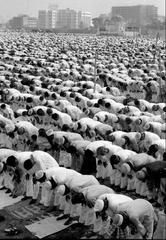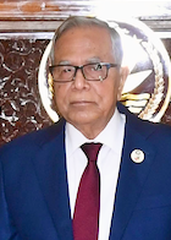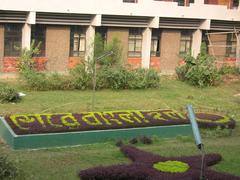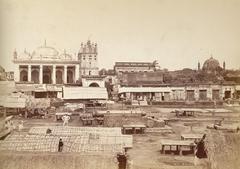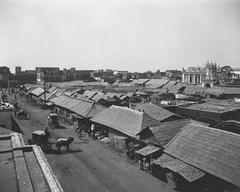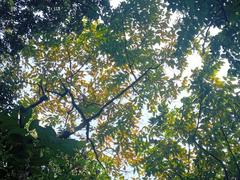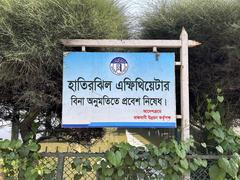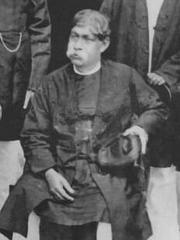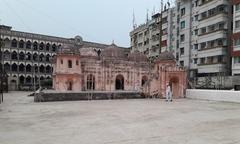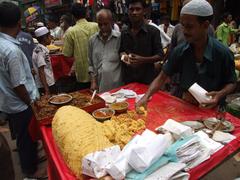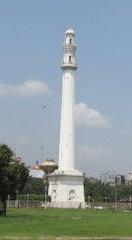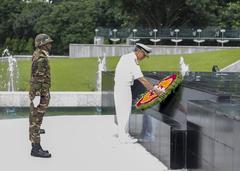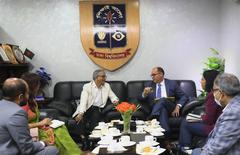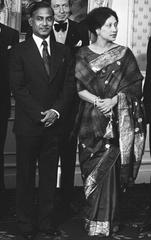Comprehensive Guide to Visiting Dhaka, Dhaka Division, Bangladesh
Date: 14/08/2024
Captivating Introduction
Welcome to Dhaka, the vibrant, pulsating heart of Bangladesh! Imagine a city where ancient empires left their mark, where the scent of sizzling street food mingles with the hum of rickshaws, and where every corner tells a story. Dhaka, with its rich history dating back to the 1st millennium, has been a melting pot of cultures, from the Hindu Sena dynasty to the grandeur of Mughal rule (source). This city, known as Jahangirnagar in the Mughal era, was a bustling hub for Eurasian traders, earning the nickname ‘Venice of the East’ (source). Whether you’re a history buff, a foodie, or an adventurer, Dhaka has something to enchant everyone. From exploring the unfinished masterpiece of Lalbagh Fort to immersing yourself in the spiritual ambiance of Dhakeshwari Temple, each experience is a journey through time and culture (source). So, buckle up and let’s dive into the endless energy of Dhaka, a city that never ceases to surprise, enchant, and enthrall!
Table of Contents
- Historical Background and Significance
- Top Attractions in Dhaka
- Discover Dhaka: A City of Contrasts and Charms
- Lalbagh Fort: The Unfinished Masterpiece
- Ahsan Manzil: The Pink Palace
- National Museum: A Journey Through Time
- Dhakeshwari Temple: A Spiritual Haven
- Sadarghat: The Lifeline of Dhaka
- Shankharia Bazar: The Vibrant Hindu Street
- Liberation War Museum: A Tribute to Bravery
- National Assembly Building: A Masterpiece of Modern Architecture
- Botanical Gardens: A Nature Lover’s Paradise
- Ramna Park: The Green Oasis
- Curzon Hall: A Colonial-Era Gem
- Fantasy Kingdom: Fun for the Whole Family
- Dhaka Zoo: Wildlife Wonders
- National Martyrs’ Memorial: A Tribute to Heroes
- Bashundhara City: Shopper’s Delight
- Visitor Tips and Practical Information
- Call to Action: Explore Dhaka with Audiala
Historical Background and Significance
Early History and Pre-Mughal Period
Imagine stepping into a city where ancient empires once thrived, where every street whispers tales of conquests and cultures blending seamlessly over centuries. The history of this vibrant city dates back to the 1st millennium CE. Initially, the region was part of the ancient district of Bikrampur, ruled by the Hindu Sena dynasty. The ancient city of Dholsamudra in present-day Gazipur served as one of the capitals of the Buddhist Pala Empire. The region also saw the construction of forts in Toke and Ekdala during the sixth century, which continued to be used until the Mughal Period. The Chandalas had their capital in Chinashkhania, and Shishu Pal ruled from modern-day Sreepur, where ruins can still be seen today.
Mughal Era
Let’s time travel to the 17th century when Dhaka rose to prominence as the capital of Mughal Bengal. Officially declared the provincial capital in 1610 by Subahdar Islam Khan I, the city was renamed Jahangirnagar in honor of Emperor Jahangir. This period marked significant architectural and economic development, with landmarks like the Lalbagh Fort, Bara Katra, and Chhota Katra caravanserais still standing as testaments to that glorious era. Dhaka’s strategic riverine location made it a hub for Eurasian traders, earning it the nickname ‘Venice of the East’ (source).
Top Attractions in Dhaka
Discover Dhaka: A City of Contrasts and Charms
Welcome to Dhaka, a city where the past and present blend seamlessly, creating a tapestry of vibrant culture, history, and modernity. Whether you’re a history buff, a foodie, or an adventure seeker, Dhaka has something to offer everyone. Let’s dive into the must-see attractions and hidden gems of this bustling metropolis.
Lalbagh Fort: The Unfinished Masterpiece
Lalbagh Fort, also known as Fort Aurangabad, is a 17th-century Mughal fort complex that remains one of Dhaka’s most iconic historical sites. Started by Prince Azam, son of Emperor Aurangzeb, this fort was never completed, leaving behind an aura of mystery. Wander through the Diwan-i-Aam, the tomb of Pari Bibi, and the Lalbagh Mosque. Feel the cool breeze as you stroll through the well-preserved gardens, a serene escape from the city’s chaos. Don’t forget to savor some traditional food from nearby Puran Dhaka. (source)
Ahsan Manzil: The Pink Palace
Step into the world of the Nawabs of Dhaka at Ahsan Manzil. This 19th-century architectural marvel, with its striking pink facade, was once the residence of the Nawabs. Now a museum, it showcases their lavish lifestyle and artifacts. Imagine the grandeur as you walk through its halls. (source)
National Museum: A Journey Through Time
Dive deep into Bangladesh’s history at the National Museum. From ancient artifacts to contemporary art, this museum offers a comprehensive overview of the nation’s heritage. It’s a treasure trove for history enthusiasts and anyone keen to understand the soul of Bangladesh. (source)
Dhakeshwari Temple: A Spiritual Haven
Dhakeshwari Temple, the heart of Hindu faith in Bangladesh, is dedicated to the goddess Dhakeswari, the protector of Dhaka. Established in the 12th century by Ballal Sena, this temple is a significant religious site, especially during Durga Puja. Feel the spirituality and witness the devotion of thousands of devotees. (source)
Sadarghat: The Lifeline of Dhaka
Experience the hustle and bustle of one of the world’s busiest river ports at Sadarghat. Located on the banks of the Buriganga River, it’s a vital transportation hub. Take a boat ride and immerse yourself in the daily life of Dhaka’s residents. (source)
Shankharia Bazar: The Vibrant Hindu Street
Also known as Hindu Street, Shankharia Bazar is famous for its lively atmosphere and traditional crafts. The narrow lanes are lined with shops selling silver jewelry, colorful garlands, and incense. It’s a cultural melting pot and a unique shopping experience. (source)
Liberation War Museum: A Tribute to Bravery
The Liberation War Museum chronicles the 1971 War of Independence, one of the 20th century’s most significant conflicts. Housed in a beautiful colonial-era building, it offers exhibits detailing the struggle for independence, including photographs, artifacts, and personal accounts. It’s a poignant reminder of the nation’s history and resilience. (source)
National Assembly Building: A Masterpiece of Modern Architecture
Designed by the renowned American architect Louis Kahn, the National Assembly Building is a modern architectural marvel. Commissioned in 1963, this unique structure serves as the seat of the National Parliament of Bangladesh. Its design and surrounding lake make it a striking landmark. Although visitors can only view it from the outside, it’s a must-see. (source)
Botanical Gardens: A Nature Lover’s Paradise
Covering 40 hectares, the Botanical Gardens in Dhaka house over 1,000 species of local and foreign plants. These gardens offer a tranquil escape and are home to a variety of birdlife. It’s the perfect spot for nature lovers and those seeking relaxation. (source)
Ramna Park: The Green Oasis
Ramna Park is one of Dhaka’s largest green spaces, offering a respite from the city’s traffic and noise. Originally a Mughal recreational area, it features lush greenery, walking paths, and a lake. It’s a popular spot for morning walks, picnics, and outdoor activities. (source)
Curzon Hall: A Colonial-Era Gem
Located within the Dhaka University campus, Curzon Hall is an architectural masterpiece from the early 20th century. This red-brick building is a hub for academic activities and a significant city landmark. (source)
Fantasy Kingdom: Fun for the Whole Family
Fantasy Kingdom, a popular theme park on Dhaka’s outskirts, offers a variety of rides and attractions, including water activities in the Water Kingdom zone. It’s a favorite destination for families and promises a fun-filled day of entertainment. (source)
Dhaka Zoo: Wildlife Wonders
Located in Mirpur, Dhaka Zoo is home to a plethora of wild animals and unique birds. It offers an educational and recreational experience for visitors of all ages and is one of Bangladesh’s largest zoos. (source)
National Martyrs’ Memorial: A Tribute to Heroes
The National Martyrs’ Memorial in Savar is a symbolic monument built in memory of the 1971 Liberation War. Standing as a tribute to those who sacrificed their lives for Bangladesh’s independence, it’s a place of national pride and attracts numerous visitors daily. (source)
Bashundhara City: Shopper’s Delight
Bashundhara City is one of South Asia’s largest shopping malls, offering a wide range of facilities, including a movie theater, food court, and gaming zone. It’s a popular destination for shopping and entertainment, attracting both locals and tourists. (source)
Visitor Tips and Practical Information
Welcome to Dhaka: The City of Endless Energy
Imagine diving into a sea of vibrant chaos, where the hum of rickshaws and the scent of sizzling street food electrify the air. Welcome to Dhaka, the beating heart of Bangladesh! Whether you’re a seasoned traveler or a curious explorer, this guide will help you navigate the city’s bustling streets, hidden gems, and rich culture with ease.
Getting Around
Navigating Dhaka can be akin to a thrilling adventure. Here’s how to tackle it like a pro:
- Public Transport: Dhaka’s buses, rickshaws, and CNG auto-rickshaws are your wheels to adventure. Buses are budget-friendly but packed to the brim. Rickshaws offer a charming, albeit slow, ride for short distances. For speedier travel, hop on a CNG auto-rickshaw—just ensure the driver uses the meter or you agree on a fare.
- Ride-Sharing Apps: Uber and Pathao are your trusty knights in shining armor, providing a safe and convenient alternative to hailing a taxi or rickshaw.
- Walking: Exploring on foot can be delightful but stay alert! Dhaka’s traffic is a beast. Use pedestrian crossings and keep your wits about you.
Accommodation
From lavish luxury to cozy budget stays, Dhaka has it all:
- Luxury Hotels: Indulge in opulence at the Westin Dhaka or the Pan Pacific Sonargaon. These hotels offer amenities like sparkling pools, fitness centers, and gourmet dining.
- Mid-Range Hotels: Enjoy comfort without breaking the bank at Hotel 71, where essential amenities meet reasonable prices.
- Budget Accommodation: For the thrifty traveler, places like Green House Bed & Breakfast provide affordable and cozy lodging.
Safety and Health
Your well-being is paramount. Here’s how to stay safe and healthy:
- Health Precautions: Stay up-to-date with routine vaccines and consider shots for hepatitis A, typhoid, and cholera. Stick to bottled or boiled water and be cautious with street food—make sure it’s freshly cooked.
- Safety Tips: Dhaka is generally safe, but petty crimes like pickpocketing can happen. Keep your belongings secure, avoid flaunting valuables, and stay vigilant in crowded areas.
Currency and Payments
Master the art of money management with these tips:
- Currency: The local currency is the Bangladeshi Taka (BDT). ATMs are plentiful, and credit cards are widely accepted in hotels, restaurants, and shops.
- Currency Exchange: For the best rates, exchange money at authorized centers or banks. Steer clear of street money changers.
Language and Communication
Break the language barrier with ease:
- Language: Bengali (Bangla) is the official language, but English is commonly spoken in tourist areas.
- Mobile and Internet: Grab a local SIM card from providers like Grameenphone or Robi for affordable mobile and internet services. Many hotels and cafes offer free Wi-Fi.
Cultural Etiquette
Immerse yourself in Dhaka’s rich traditions with these etiquette tips:
- Dress Code: Dress modestly, especially at religious sites. Women should cover their shoulders and knees.
- Greetings: A warm “Assalamu Alaikum” (Peace be upon you) goes a long way. Handshakes are common, but some women may prefer not to shake hands with men.
- Photography: Always ask before snapping photos of people, particularly in rural areas or at religious sites.
Food and Dining
Embark on a culinary journey through Dhaka’s flavors:
- Local Cuisine: Savor traditional dishes like biryani, hilsa fish, and pithas (rice cakes). Check out local favorites like Star Kabab and Nirob Hotel.
- International Cuisine: Craving global flavors? Try Izumi for Japanese delights or Spaghetti Jazz for Italian fare.
- Street Food: Don’t miss out on street food! Choose vendors with good hygiene and try fuchka (pani puri) and chotpoti.
Shopping
From bustling markets to sleek malls, Dhaka’s shopping scene has something for everyone:
- Traditional Markets: Dive into markets like New Market and Baitul Mukarram Market for traditional clothing, handicrafts, and souvenirs.
- Modern Malls: For a contemporary shopping experience, visit Bashundhara City Mall or Jamuna Future Park.
Attractions and Activities
Discover Dhaka’s rich history and vibrant culture:
- Historical Sites: Step back in time at Lalbagh Fort and Ahsan Manzil.
- Museums: Learn about Bangladesh’s heritage at the National Museum and Liberation War Museum.
- Parks and Gardens: Unwind at the Botanical Gardens or stroll through Ramna Park.
Festivals and Events
Experience Dhaka’s festive spirit:
- Pohela Boishakh: Celebrate the Bengali New Year on April 14th with parades, music, and dance.
- Eid Festivals: Join the joyous celebrations of Eid-ul-Fitr and Eid-ul-Adha, marked by communal prayers and feasts.
- Durga Puja: Witness the grandeur of Durga Puja, a major Hindu festival with elaborate decorations and rituals.
Emergency Contacts
Keep these numbers handy:
- Police: Dial 999 for emergency assistance.
- Medical Emergencies: Call 199 or visit major hospitals like United Hospital or Apollo Hospital.
- Embassies: Locate your country’s embassy or consulate in Dhaka for emergency assistance.
Call to Action: Explore Dhaka with Audiala
Ready to explore Dhaka like never before? Download Audiala today for personalized recommendations, interactive maps, and exclusive content. Discover the city’s best-kept secrets and make your trip unforgettable!
References
- Best places to visit in Dhaka Division, mybangla24, 2024 (source)
- Dhaka City Attractions, Lonely Planet, 2024 (source)
- Dhaka City Tour: Dos and Don’ts for the Ultimate Experience, medium, 2024 (source)










